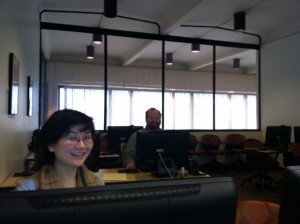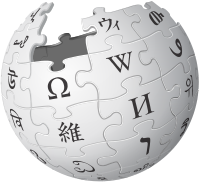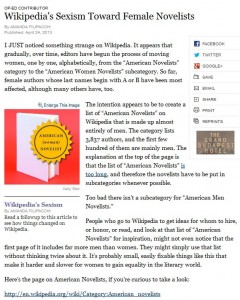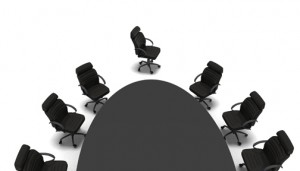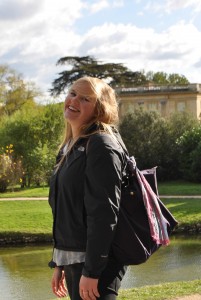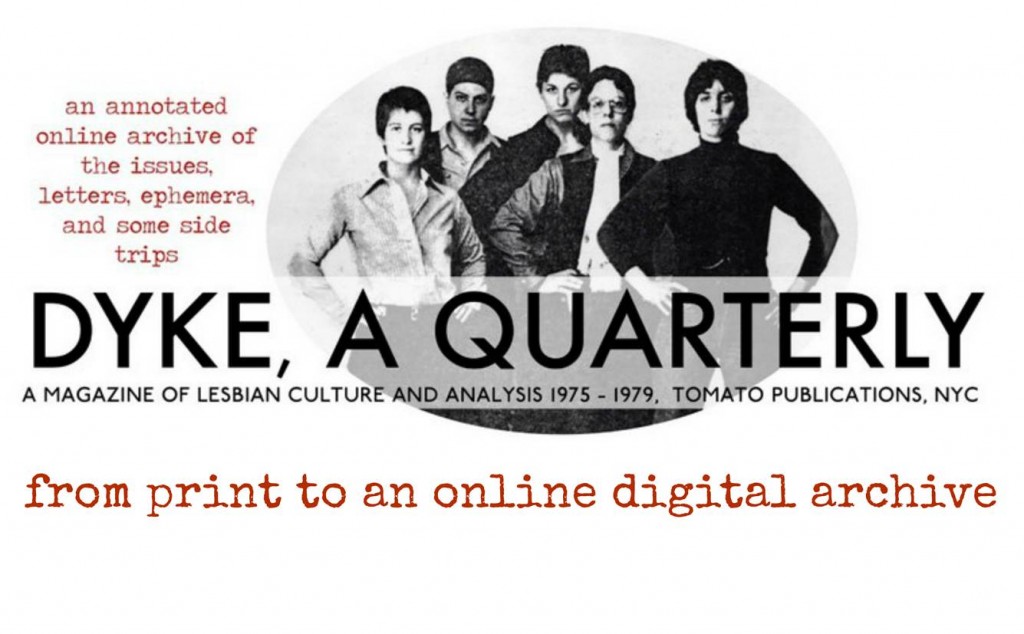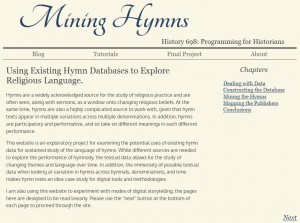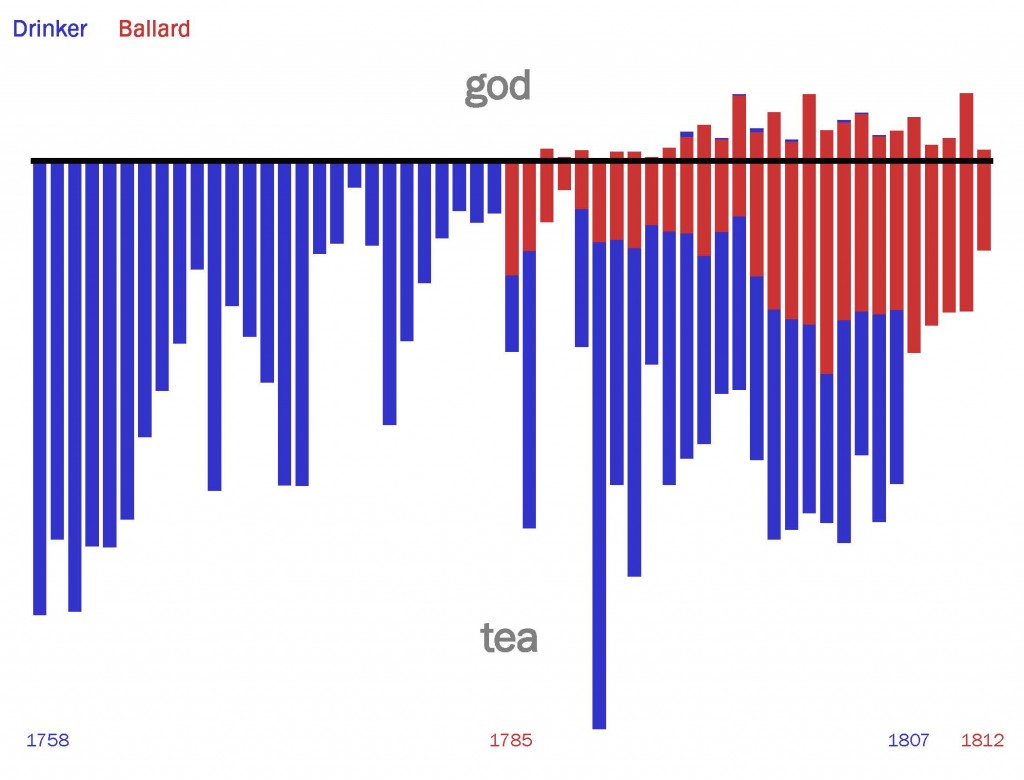 Bryn Mawr has just been awarded a $39,650 grant from the National Endowment for the Humanities for its “History of Women’s Education Open Access Portal Project,” being run through the Greenfield Digital Center. This will be a one-year project to plan and conduct pilot work for an online portal to archival sources pertaining to the history of women’s higher education in the United States, and it is being done in collaboration with the special collections departments of the other Seven Sisters Colleges: Barnard, Mount Holyoke, Smith, Vassar, Wellesley, and the Schlesinger Library, Radcliffe Institute for Advanced Study, Harvard University. We will be posting much more about this exciting project in the coming months!
Bryn Mawr has just been awarded a $39,650 grant from the National Endowment for the Humanities for its “History of Women’s Education Open Access Portal Project,” being run through the Greenfield Digital Center. This will be a one-year project to plan and conduct pilot work for an online portal to archival sources pertaining to the history of women’s higher education in the United States, and it is being done in collaboration with the special collections departments of the other Seven Sisters Colleges: Barnard, Mount Holyoke, Smith, Vassar, Wellesley, and the Schlesinger Library, Radcliffe Institute for Advanced Study, Harvard University. We will be posting much more about this exciting project in the coming months!
Tag Archives: Digital humanities
Writing the Collective Record: on Delving into Wikipedia
Featured
Bryn Mawr Special Collections is jumping on the edit-a-thon bandwagon!
This past Friday, we held a small trial run Wikipedia edit-a-thon: a gathering at which people work on adding to or editing articles on the encyclopedia website, often organized around a specific topic. The goal of the endeavor is multifaceted: we want to add information pertinent to our collections in order to increase awareness of our holdings; to improve general knowledge by enhancing existing articles with additional information; and to add to the global body of accessible knowledge on women and women’s history. I have begun writing a new article for Hilda Worthington Smith (not yet posted), a Bryn Mawr alumna who played a lead role in The Summer School for Women Workers in Industry in the 1920s and ’30s. Other colleagues added new articles, improved existing articles by adding links to our holdings, and interlinked between articles. This initial trial helped us to to gauge the challenges, feasibility, and possible benefits of holding similar events in the future with a broader group of participants.
Why Wikipedia? Surely there are other channels by which we might accomplish these goals–channels that are more reputable, or more specialized. Our alumnae, for instance, would be more likely to read about highlights from our collections through the Alumnae Bulletin, researchers can find us through networks of finding aids and citations, and anybody with an internet connection can browse the Triptych and Triarte databases to view the art objects, images, and documents that we hold. But the draw of Wikipedia isn’t specialization–it’s precisely the opposite.
With the abundance of information available on the internet growing every second, people are relying increasingly on powerful aggregators like Google and sites like Wikipedia which provide a centralized source for general knowledge. This is valuable and useful, but also cause for concern. As the amount of information covered by these tools grows, they take on the illusion of completeness. The phenomenon is summed up aptly by Wikipedia founder Jimmy Wales with the “Google test: ‘If it isn’t on Google, it doesn’t exist.'” (If a tree falls in a forest…) If it doesn’t exist on Wikipedia, the public perception is that it must not be very important.
Professors are notoriously uneasy with their students’ reliance on Wikipedia, and have been known to decry its democratic structure as a free-for-all for self-appointed journalists spreading unreliable information. While the concern may be overblown (the site actually has strict rules about citation and regularly cleans out content of poor quality), it is true that Wikipedia is only as reliable as those who participate in writing and editing it. Like all sources, its assertions should be interrogated rather than blindly accepted. The legitimate fear is not that it is fallible, but that its readers will forget that it is so. Once we recognize it as an incomplete,  occasionally inaccurate, and highly mutable record, the conversation becomes much more interesting. If it is not a record of “everything,” what is it a record of? The diagram on the right is my interpretation of what it looks like to begin to refine our understanding of Wikipedia’s relation to wider cultural knowledge. I have never spoken to a person who actually believes the statement in stage 1, but my perception is that many people are stuck at stages 3 and 4. Versions of the statement in stage 5 have recently emerged at the center of dialogue in feminist and digital communities about the role that Wikipedia plays in our cultural knowledge, the assertion among feminists being that it both reinforces systemic problems and also provides opportunities for reform, which it becomes our responsibility to take.
occasionally inaccurate, and highly mutable record, the conversation becomes much more interesting. If it is not a record of “everything,” what is it a record of? The diagram on the right is my interpretation of what it looks like to begin to refine our understanding of Wikipedia’s relation to wider cultural knowledge. I have never spoken to a person who actually believes the statement in stage 1, but my perception is that many people are stuck at stages 3 and 4. Versions of the statement in stage 5 have recently emerged at the center of dialogue in feminist and digital communities about the role that Wikipedia plays in our cultural knowledge, the assertion among feminists being that it both reinforces systemic problems and also provides opportunities for reform, which it becomes our responsibility to take.
While Bryn Mawr Special Collections will use the site to provide better access to our collections in general, the edit-a-thons also align particularly with the mission of The Greenfield Digital Center to build recognition of women in digital spaces. It is important to ensure that women and minority voices have a presence on Wikipedia, simply because it is so many people’s main reference for information–otherwise we risk losing sight of them entirely. Last Fall, our former Director Jennifer Redmond led a history class through the process of improving the Wikipedia article for M. Carey Thomas, demonstrating the incompleteness of what some view as the “official” record and the importance of taking the steps we can to fill in the gaps.
The volume of the conversation around gender in Wikipedia rose to a new pitch in April 2013 when Amanda Filipacchi noticed a disturbing trend: Wikipedia editors were gradually moving women from the general “American Novelists” listing to a marginal sub-category called “American Women Novelists,” leaving the original list, with name still ungendered, exclusively male. This observation raised crucial questions about the visibility of marginalized groups and the responsibility of editors and others to consciously address these problems. Her article, and the flood of ensuing coverage, brought new focus to a conversation about the under-representation of women on the site–both as subjects of content and in their roles as contributors. (A useful summary of the conversation can be found here.) The dialogue became an opportunity to reflect on the systemic nature of sexism, and the insidious feedback loop between structural problems in society and sources like Wikipedia: culture reinforces its imbalances by creating a record that reflects them, replicating the existing flaws like mutated DNA as it constantly remakes itself in the image of the problematic record. In other words, rather than a record of the world itself, Wikipedia serves as a mirror of our worldview with the power to either perpetuate or transform the problems it contains.
The Importance of Participation: the best way to fix it is to get our feet wet and address the matter at the source of the controversy, and organized efforts like The Rewriting Wikipedia Project are taking the reigns. The under-representation of women, gender non-conforming individuals, people of color, and others on Wikipedia is a site-specific manifestation of a universal problem. By adding to and editing Wikipedia, therefore, we address two areas in need of change: we fill in the gaps that exist between the site and our culture, adding in those who have been left out of the encyclopedia but have achieved recognition by society outside the digital realm. (Examples include the women mentioned in this article who have won prestigious STEM awards but go unrecognized on Wikipedia). Additionally, in adding in those who have been neglected either on the site or in general society, we take steps towards correcting those lacks in the culture itself, from beyond and before Wikipedia: we reassert the importance and visibility of the marginalized, affirming their place in history and their right to be known. Because of its open structure, Wikipedia is more than just a mirror of the status quo: it is also a potential locus of powerful change.
Therefore, edit! Setting up a Wikipedia account is easy. Learning the editing protocol is a little bit more of an investment, but can be easily covered within an hour. By taking an organized approach to adding information into the site we can support each other as we learn how to edit, ask questions about material and learn about the collections, and make a difference in the visibility of Bryn Mawr’s remarkable collections and of women’s accomplishments in history. Edit-a-thons have been picking up all over the world, with growing frequency in past years, and we plan on holding another one in March to coincide with a Seven Sisters series of edit-a-thons for Women’s History Month. In the meantime, we will be publicizing and participating in events like the upcoming Art and Feminism edit-a-thon* on Saturday, February 1st, in order to continue to get our feet wet and learn the ins and outs of the site.
If you’re interested in getting involved with a future event, please write to us at GreenfieldHWE@brynmawr.edu and follow us on Twitter! @GreenfieldHWE
*Update: remote participants are more than welcome at edit-a-thons, but if you’re in a major city chances are good that you could participate in the Art and Feminism edit-a-thon in person. More fun and usually free food! Check this page for a full listing of participating organizations to see if there is someone hosting a gathering near you.
Thoughts on feminism, digital humanities and women’s history
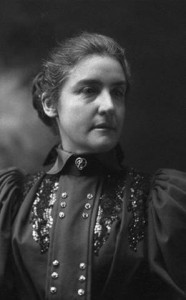
M. Carey Thomas, Bryn Mawr College’s first female president, is the subject of a new digital exhibit to be launched soon
I have been exploring my thoughts on women’s history, digital humanities, and feminism through two separate presentations in recent months, the first at the conference organized by The Albert M. Greenfield Digital Center for the History of Women’s Education, Women’s History in the Digital World (March 2013), and the second at the Five Colleges Mediating Public Spheres: Genealogies of Feminist Knowledge in the Digital Age conference (April 2013). In a presentation at the latter conference, titled Open Source Technology and Feminist Perspectives: Translating Sources on the History of Women’s Education to the Digital Age I explained my feminist approach to my work at the Digital Center, focusing on a digital exhibit on M. Carey Thomas that is underway and will be launched soon. This blog post represents a synthesis of the two papers, based on work and thoughts in progress… all comments and feedback welcome as I work through some of the concepts I’ve been grappling with.
My thoughts on the trifecta of feminism, digital humanities and women’s history are largely drawn from my experiences using the open source software platform, Omeka, and our institutional enterprise version of Word Press to populate different areas of the Digital Center’s site, in addition to my training as a CLIR Postdoctoral Fellow. While I assume that neither of these tools were designed with feminist notions in mind, I’ve come to believe that they have large potential to be utilized for feminist outcomes, particularly Omeka, as I will explain further in this post. Primarily, the Center’s site aims to tell stories in the history of women’s education that emanate from different perspectives. As Hermione Lee has said in her collection Virginia Woolf’s Nose: Essays on Biography, “We all want stories”, and the demand for such stories in the digital age is no less (possibly more, in fact) than ever before.[1]
The digital age and the tools it provides allow for a different mediation of knowledge than standard forms of scholarly communications. As noted by Abby Smith Rumsey these new methods have brought “fundamental operational changes and epistemological challenges [that] generate new possibilities for analysis, presentation, and reach into new audiences”.[2] The exhibit format in Omeka is designed to allow for the easy presentation of original historical material, such as images, transcriptions and audio files. This allows for the greater sharing of primary source materials, itself a way to decolonize and break down barriers to research and access to rare materials. We have created a number of exhibitions on our site, some of which have been generated as a result of student work from a class I teach on the history of women’s education, some of which come from collaborations with other colleges, and some drawn from our own collections and created by me and my team (see here for the full range of exhibits we have developed so far).
Our endeavor to produce digital source material comes from a desire to transmit knowledge and awareness of women’s history to the broadest audience possible: fellow researchers, students, teachers, alumnae, digital humanists and those simply with a desire to learn more about the topic–in essence, the public sphere has expanded in the digital age, although there are still challenges to be faced in greater online access morphing into another form of the ‘digital divide’.
Upon learning the new software platform and becoming familiar with its characteristics, possibilities and constraints, I realized that the Omeka exhibit format allows for the subject matter to be presented in a deconstructed narrative, due to the free form it provides for creating the digital exhibit. This struck me as having strong feminist potential: while the structure allowed by the Omeka format is cohesive in terms of form and flow, the sectioning of a biographical narrative allows for the fragmentation of the story, and in my efforts, for the development of a kaleidoscopic view, or, to paraphrase Henry James, to let the “swarm of possibilities” that nebulously make up a person’s biography to emerge, rather than a “few estimated and cherished things”.[3] This is, in my view, one of the pivotal means by which to incorporate digital media in feminist scholarship and practice.
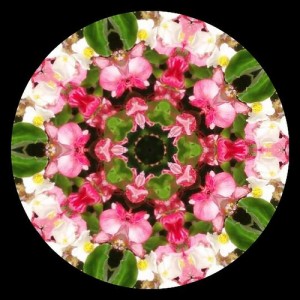
Image by klmontgomery licensed under a Creative Commons license and available here http://www.flickr.com/photos/klm_digital_snaps/1444968874/sizes/m/in/photostream/
In a feminist postmodern tradition, this approach posits that there is no ONE person for us to study, no One Truth we can ascribe to a person or their life history. In this case, M. Carey Thomas, born in Baltimore, Maryland on January 2, 1857 to a prominent Quaker family. Thomas was the first Dean and later the first female President of Bryn Mawr College and a national leader in women’s struggle for access to higher education and the suffrage movement. My feminist approach to her biography aims to be cognizant of the privilege in stories such as hers: the history of women’s entry into higher education is an elite history, and recognition of this is necessary so that the histories we tell are not merely celebratory without being interrogative.
Here I am focusing on Thomas as she was seen from different perspectives: her own (for example, her ambitious articulations for her education and career in the letters and diaries that span her time at Quaker boarding school, on to Cornell, Johns Hopkins and eventually a summa cum laude PhD from the University of Zurich), those of her contemporaries, lovers, friends and family, the public and the way in which she was memorialized after her death in 1935. I am focused here, however, not on the details of her biography (although this will be in the exhibit) but rather on examining the potential of an open source software tool to present critical historical analysis of this fascinating person. The ability to juxtapose different opinions by placing them on the same page is more visually and comprehensively impactful in a digital exhibition format than would be the effect of a written paragraph: in traditional biographical accounts such as an article or monograph, editorial and stylistic conventions would view such jumping around as incoherent, and yet it can be seamless in an online presentation.
Making sure our metadata is harvested by the major search engines and databases and using social media to reach both scholarly and public audiences will both be crucial in building up a new body of feminist genealogies and for tracing feminist work in the digital era. The metadata itself also needs to be cognizant of feminist principles in describing women’s identities in digital databases, as was mentioned by Professor Laura Mandell in her keynote speech at the Women’s History in the Digital World conference.
It is also imperative that as we do work that mediates the public sphere in the digital age we think about its long term preservation. This requires that choices be made, funding be sourced and policies be formulated now – it would be the greatest tragedy of all if we found ourselves unable to trace back the exciting developments in feminist work that have been produced in online public spaces. The familiar academic mantra of ‘publish or perish’ might be usefully adapted in this context to be ‘archive or perish’. And, as I remarked at the Women’s History in the Digital World conference that was held at Bryn Mawr College, I believe fundamentally in the idea that the ‘add women and stir model’ for any kind of initiative, social, political education or anything else, rarely works.
In the new era of digital humanities, women need a seat at the table while it’s still being set, not after the main course has been served. As I researched for this paper, I discovered that others in the digital humanities community have also used the “table” to describe the need to collaborate, critique and engage in new developments. Alan Liu has argued that digital humanists need to be equal partners at the table, not just a servant, when critical conversations are happening about the way forward for the humanities and cautions that digital humanists need to include more cultural critique in their work.[5] Moya Bailey extends Liu’s concerns into more explicitly feminist territory with her arguments that the “ways in which identities inform both theory and practice in digital humanities have been largely overlooked” and that moving from “the margin to the center” gives the opportunity to “engage new sets of theoretical questions that expose explicit structural limitations that are the inevitable result of an unexamined identity politics of whiteness, masculinity and ablebodiness”.[6] Alan Liu’s point was that the “digital humanities have a special role to play today in helping the humanities communicate in contemporary media networks”.[7] I would extend this argument to say that feminists have a special role in mediating the present and future public spheres, through their research, pedagogy and activism. Here the words of M. Carey Thomas are apt: reflecting on the success women had made of educational attainment in the first twenty-five years of the Association of Collegiate Alumnae, she stated “The fearsome toads of those early prophecies are turning into pearls of purest radiance before our very eyes.”[8] Let’s hope it’s the same for us as we feminists navigate the new public spheres and create our own genealogies of knowledge.
[1][1] Hermione Lee, Virginia Woolf’s Nose: Essays on Biography, Princeton University Press: Princeton, 2005: 1.
[2] Smith Rumsey , New-Model Scholarly Communication: Road Map for Change (2011: 2).
[3] As quoted in Hermione Lee, Virginia Woolf’s Nose: Essays on Biography, Princeton University Press: Princeton, 2005: 1.
[4] Anne Balsamo, Designing Culture: The Technological Imagination at Work, Duke University Press: 2011: 51.
[5] Alan Liu, ‘Where is Cultural Criticsim in the Digital Humanities?’ available from http://liu.english.ucsb.edu/where-is-cultural-criticism-in-the-digital-humanities/
[6] Moya Z. Bailey, ‘All the Digital Humanists Are White, All the Nerds Are Men, but Some of Us Are Brave’, Journal of Digital Humanities, Vol. 1, No. 1 Winter 2011, available from http://journalofdigitalhumanities.org/1-1/all-the-digital-humanists-are-white-all-the-nerds-are-men-but-some-of-us-are-brave-by-moya-z-bailey/
[7] Alan Liu, ‘Where is Cultural Criticsim’.
[8] Thomas, Women’s College and University Education: Address delivered at Quarter-Centennial Meeting of the Association of Collegiate Alumnae, Boston, November 6, 1907.
Available in digital form on the website of The Albert M. Greenfield Digital Center for the History of Women’s Education by clicking here. You can view the original by visiting Special Collections, Bryn Mawr College.
“I’m not a historian but I am interested in people’s stories”: Lianna Reed ’14 reflects on working on Bryn Mawr College oral histories
In this guest post by Lianna Reed ’14, you can learn more about the digitization of the oral history collection held by the Special Collections department of Bryn Mawr College. As part of its work, The Albert M. Greenfield Digital Center for the History of Women’s Education is converting the audio tapes into digital files which will eventually be hosted on the Tri-College digital repository site, Triptych.
Previously, student worker Isabella Barnstein worked on the project and wrote about her experiences. We are further along with the work now and finding out more and more about alums from the past. Some of the material has been used in our Taking Her Place exhibition which can be linked to by scanning QR codes on certain labels. These include the 1935 radio broadcast by M. Carey Thomas and interviews with faculty, staff and students in the past (you can find them by clicking this link to our site). The exhibition runs until June 2nd and after this it will be made available as a digital exhibit on our site so make sure to visit the digital exhibitions section of the site ….
I have been working on the oral history project with The Albert M. Greenfield Digital Center for the History of Women’s Education for three months and not only have I learned how to digitize cassette tapes to mp3 files but I have also been absorbed into the lives of Bryn Mawr women from ten, twenty even eighty years ago. I’m not a history major or English major, in fact my academic work doesn’t usually relate to my work with Special Collections. I actually appreciate this difference because working here is a release from my academic life as a double major in Political Science and French. I get to come to work and listen to alumnae talk about their time as students in the 1940s, sneaking out of the dorms past curfew (10pm) and going to the cemetery down the road. I become immersed in the details of women who became renowned archaeologists, politicians, activists, tutors, and the list goes on and on. Oral histories are an interesting form of history because they involve someone else, usually the interviewer, prompting the interviewee to respond to certain questions. However with Bryn Mawr women, these questions are often disregarded as the women believe that they themselves aren’t interesting. I have heard so many women say “Oh, you don’t want to hear about that. It isn’t interesting.” Actually, most things are interesting, especially anecdotal commentary. Even when the women describe how challenging Bryn Mawr was and their feelings about not using the degree, prompting them to feel unworthy of their degree, it is interesting and valuable for the history archives and also for those of us that are soon to be graduates.
My first oral history was my most memorable. Fleta Blocker was a bell maid in Radnor who came to Bryn Mawr as a teenager on the recommendation of her sisters. Too young to work she was put on staff for a trial year before she was hired permanently. Fleta would end up working for forty years at Bryn Mawr College. Honored as one of the longest serving employees at Bryn Mawr, Fleta wasn’t just a bell maid, she was a friend and a student herself at Bryn Mawr. Fleta saw more change and development at Bryn Mawr than anyone else. But what does it means for Bryn Mawr’s Special Collections digital archives to have Fleta’s interview? Who will listen to her tell her story? Who will understand what it meant to her and, of course, the students, to have her there in the dorm? While Fleta’s interview is linked on the website of The Albert M. Greenfield Digital Center for the History of Women’s Education and featured in the Taking Her Place exhibition and we can track who listens and in what language, we can’t always know how they might understand Fleta’s time at Bryn Mawr in the college’s history. Maybe oral histories are like podcasts and while you can’t force anyone to listen to them, they are an integral piece of history that is accessible, not just for the Bryn Mawr community but for the community of women’s education around the world. Faculty are always celebrated for their accomplishments and their connections with publically accomplished students, but what about the other people who supported and encouraged students to become the people they are remembered to be?
What does working on this project mean for me? As I said I am not a historian but I am interested in people’s stories. I am interested in doing research in sub-Saharan Africa on the effects of transitional and restorative justice. Oral histories are one of the most important forms of archival material that we have as humans. Oral tradition is the way we know and remember songs, family history, and recipes we love to cook. Oral history and oral tradition help to clarify the ways in which restorative justice has impacted the lives of many. For example, the gacaca courts in Rwanda are an oral tradition that are both a method of enacting justice and also a form of history as the plaintiffs, witnesses and criminals participate in an open dialogue. These histories are invaluable to the success and development of Rwanda in the present day. I hope that after having listened to hundreds of different interviews from people reluctant to talk and people more than enthusiastic at Bryn Mawr I will be prepared for whatever might come my way in the field. When I am out in the field I can gather information necessary to create a dialogue, not only amongst those I am interviewing but also with the wider international community producing a discourse that gathers many people’s individual stories, much like the archives at Special Collections at Bryn Mawr College.
Conference Presentations Available Online: Women’s History in the Digital World Repository
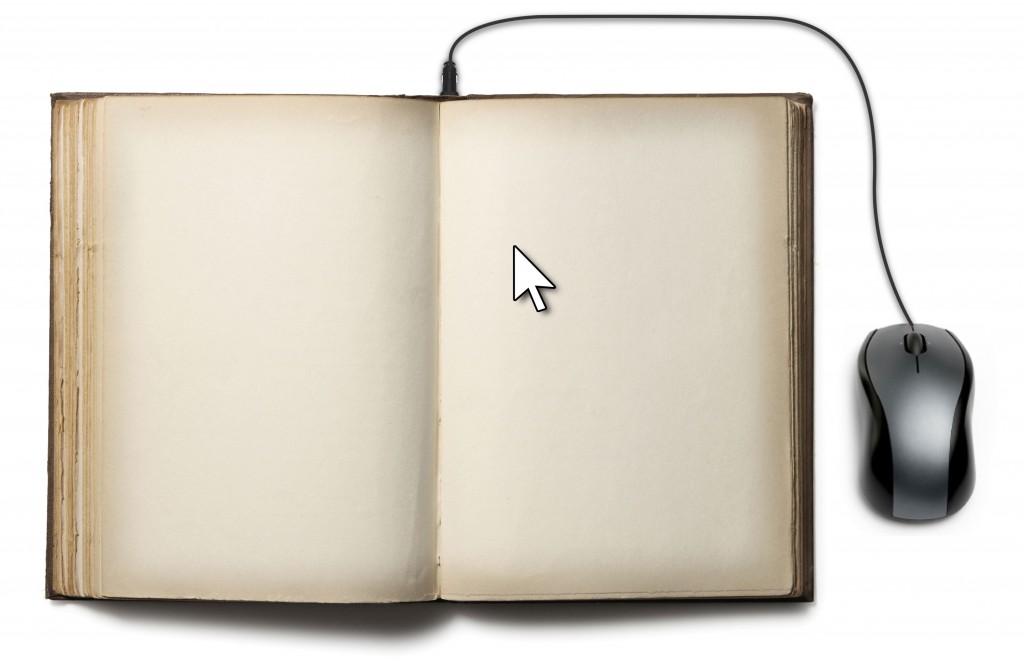 On March 22nd and 23rd, 2013, a compelling group gathered for the Women’s History in the Digital World conference to discuss an array of the fascinating projects that are emerging at the crossroads of the digital humanities and women’s and gender studies. The conference sparked dialogues across both the physical and the digital realms, as animated exchanges took place on Twitter alongside those that were ignited in person (viewable as a Storify of tweets using the conference hashtag, #WHDigWrld, thanks to the creative ‘wordsmithing’ of presenter Michelle Moravec). One of the most exciting outcomes of the event is the extension of those conversations beyond the spaces in which they originated: we are now looking to gather the presentations from the weekend in the form of speaking notes, slides, links to project and social media pages and other supplementary materials, to make them available to all on our conference website. For the many who were not able to attend in person, this resource will provide an opportunity to engage with the work and see the variety of research endeavors that are currently underway in the field. For those who were present, the repository offers a new chance to view presentations that conflicted with other panels, or to revisit work that may have stirred thoughts that called for deeper inquiry. We hope that the site will serve to sustain the conversations that emerged at the conference, as well as foster new dialogues with a wider participatory base than those who were able to convene in March.
On March 22nd and 23rd, 2013, a compelling group gathered for the Women’s History in the Digital World conference to discuss an array of the fascinating projects that are emerging at the crossroads of the digital humanities and women’s and gender studies. The conference sparked dialogues across both the physical and the digital realms, as animated exchanges took place on Twitter alongside those that were ignited in person (viewable as a Storify of tweets using the conference hashtag, #WHDigWrld, thanks to the creative ‘wordsmithing’ of presenter Michelle Moravec). One of the most exciting outcomes of the event is the extension of those conversations beyond the spaces in which they originated: we are now looking to gather the presentations from the weekend in the form of speaking notes, slides, links to project and social media pages and other supplementary materials, to make them available to all on our conference website. For the many who were not able to attend in person, this resource will provide an opportunity to engage with the work and see the variety of research endeavors that are currently underway in the field. For those who were present, the repository offers a new chance to view presentations that conflicted with other panels, or to revisit work that may have stirred thoughts that called for deeper inquiry. We hope that the site will serve to sustain the conversations that emerged at the conference, as well as foster new dialogues with a wider participatory base than those who were able to convene in March.
Several participants have already sent in their materials. In addition to the abstracts and bios we have uploaded the conference related materials we have been given so far. You can search all of this material on the conference website using the search box in the upper right hand side as seen in the screen shot below. 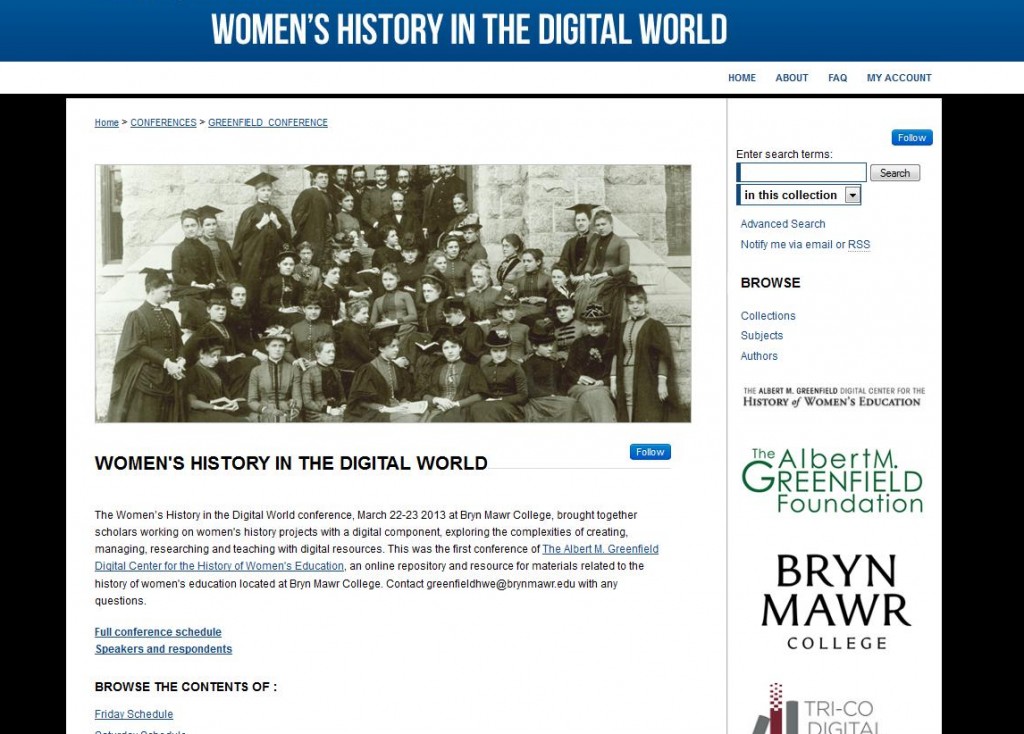
The conference repository can be searched by keyword, presenter name, institution etc., whatever term you would like to use to draw together material from the many different conference presentations. We encourage all presenters to send us their materials – you will not be able to upload the documents yourself, this must be done by us.
Update: presentations with materials uploaded are now marked on the Saturday schedule with a red “presentation available” indicator to make browsing easy.
Among the work that has been uploaded so far are the presentations on DYKE, A Quarterly: Blogging an Online Annotated Archive; Mining Hymns: Exploring Gendered Patterns in Religious Language; Digital Diaries, Digital Tools: A Comparative Approach to Eighteenth-Century Women’s History; and The New Hampshire Historic Dress Project. These and others can be found on the conference site as described above, or you may click the images below to view the materials directly.
Many thanks to those who have shared their work in this open access forum. If you participated and would like to make your presentation materials in any form available to the public, please send them to greenfieldhwe@brynmawr.edu and we will make sure to post them for you! Don’t forget to include your website and/or social media information. You may direct questions to our Director, Jennifer Redmond, at jredmond@brynmawr.edu. Or find us on Twitter @Greenfield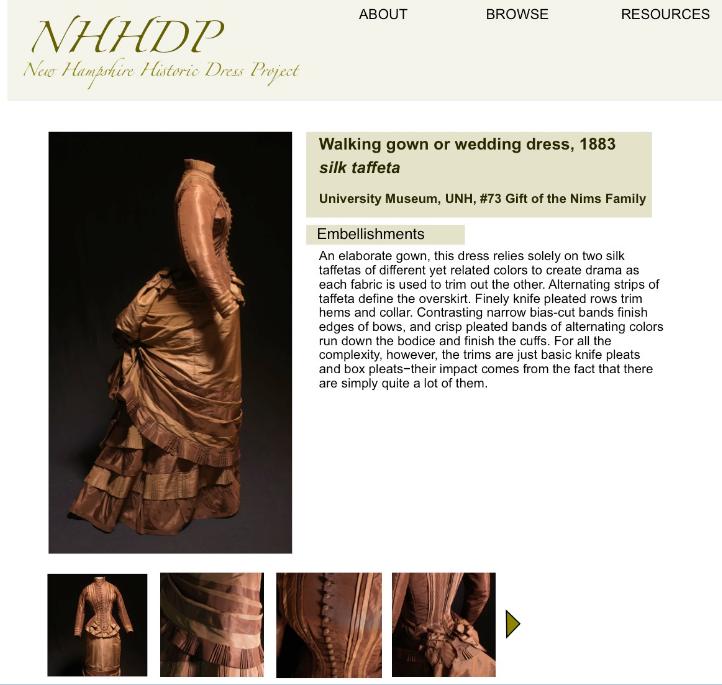 HWE
HWE
‘Women’s History in the Digital World’ Conference 2013: Vibrant and Absorbing Conversations on Women’s History
The Albert M. Greenfield Digital Center for the History of Women’s Education held its first major conference, examining issues in women’s history, gendered analysis, technology and the digital humanities on Friday and Saturday, March 22-23, 2013. Almost one hundred scholars, students, independent researchers, archivist, librarians, technologists and many others gathered at Bryn Mawr College to discuss their work at the first Women’s History in the Digital World conference.
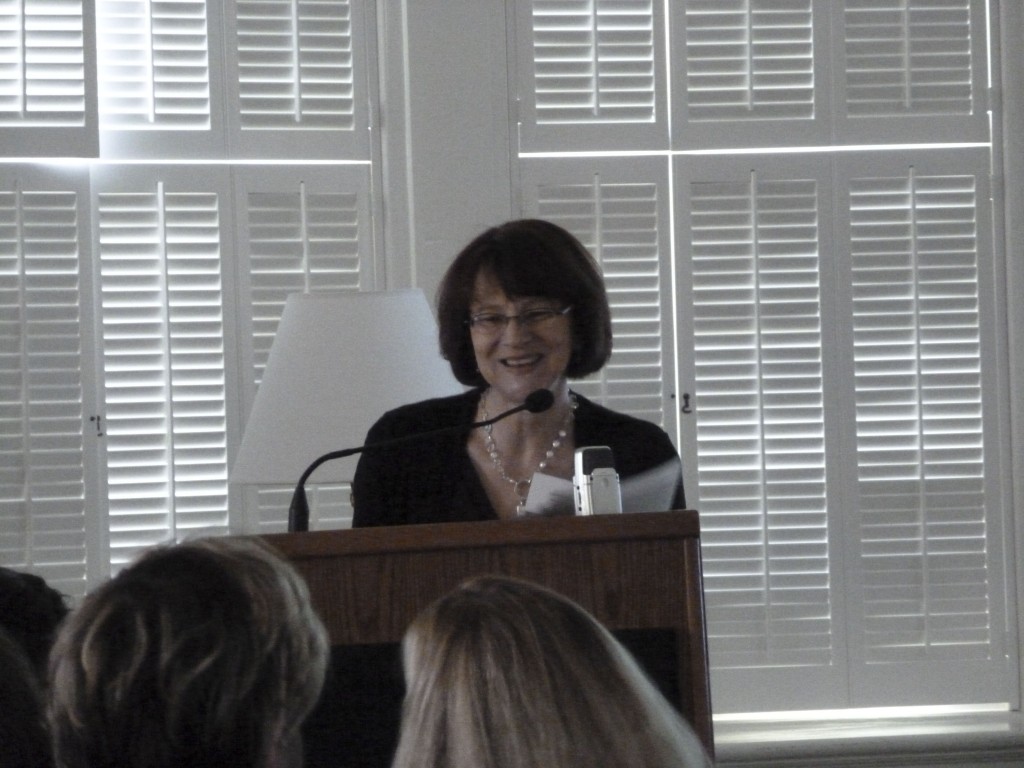
Keynote speaker Professor Laura Mandell, Director of the Initiative for Digital Humanities, Media, and Culture and Professor of English at Texas A&M
The conference opened on Friday afternoon with a provocative and inspiring keynote by Laura Mandell of Texas A&M, “Feminist Critique vs. Feminist Production in Digital Humanities.” The talk advocated that those whose work seeks to recover marginalized histories and perpetuate them in digital form must actively produce new work that embodies criticism, rather than only publishing critiques of existing work. Her speech raised several points that served as touchstones throughout the weekend for the attendees and presenters, many of whom are currently grappling with the challenge of giving digital presence to marginalized voices. How does the modern scholar produce work that is compatible enough with mainstream practices to guarantee visibility and sustainability, without undermining the ways in which these stories deviate from the mainstream? Her talk will be made available shortly on the conference website so please keep an eye on this site for more content.
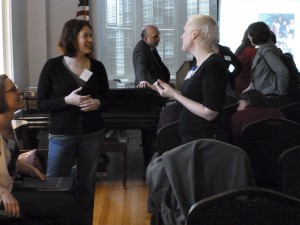
Conference attendees converse after the keynote on Friday March 22nd at Wyndham Alumnae House, Bryn Mawr College
The conference was a forum for many rich conversations, and thanks to Twitter you can follow the discussions by searching the official conference hashtag #WHDigWrld. Conference participant Professor Michelle Moravec (@ProfessMoravec), Rosemont College, created a Storify of the Tweets and a blog on her reflections about the conference. Nancy Rosoff (@NancyRosoff), Arcadia University, has also written a blog post about the conference including excerpts from her paper. We are encouraging all presenters to upload information to the conference website which uses the Bepress software, acting as a repository and an archive of the conference.

Bryn Mawr College undergraduate Lianna Reed ’14 helped at the conference. She’s pictured here at the registration desk in Thomas Hall, the venue for the second day of the conference.
Conference panels were held all day on Saturday March 24th related to the four panel session overarching themes: Pedagogy: Digital Sources and Teaching in Women’s History; Developments in Digital Women’s History; Digital Archives and Practices and finally, Culture and Representation in the Digital World.
The conference ended with a roundtable with participation from Cheryl Klimaszewski, Digital Collections Specialist, Bryn Mawr College, Cathy Moran Hajo, Ph.D., Associate Editor/Assistant Director, The Margaret Sanger Papers Project, New York University, Christine A. Woyshner, Ed.D., Professor of Elementary Education /K-12 Social Studies, Temple University and moderated by Jennifer Redmond, Director of The Albert M. Greenfield Digital
Center for the History of Women’s Education, Bryn Mawr College. Topics that arose included the difficulties in funding and sustaining funding for digital humanities projects related to women’s history; what a digital humanities ‘toolkit’ should look like for those interested in developing their skills; funding opportunities and potential collaborations between the conference participants and the importance of networking, sharing information and collaborating with each other.
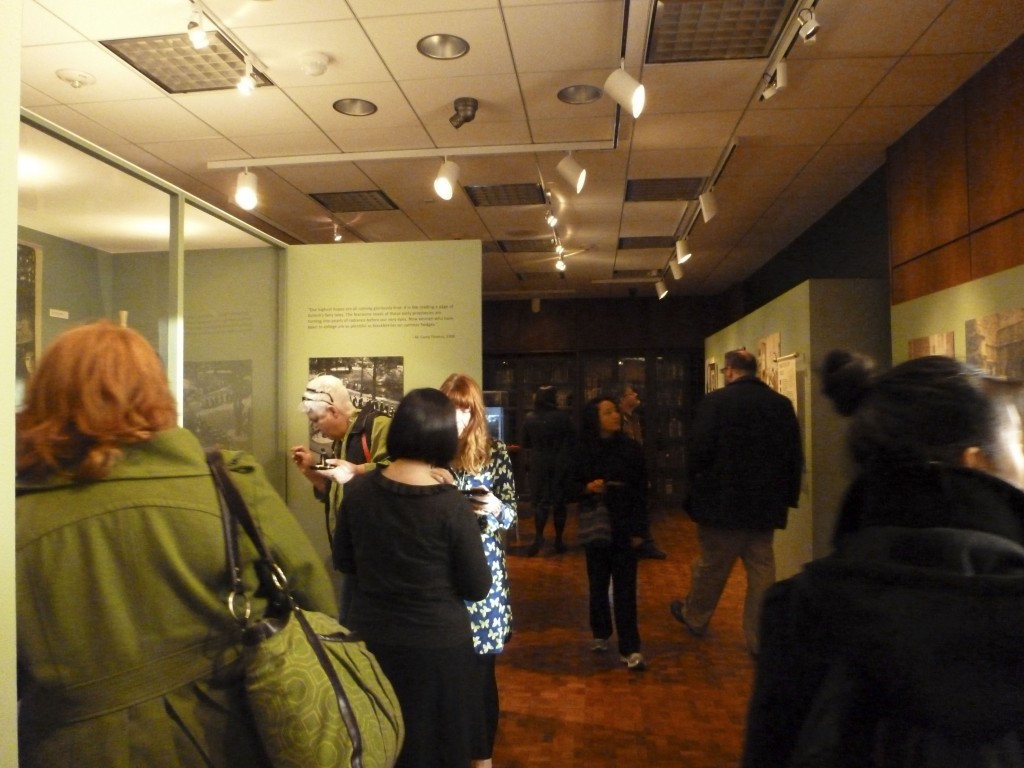
The closing reception at the conference was held in the Rare Book Room Gallery, Canaday Library, Bryn Mawr College. Conference participants were able to wind down and explore the Taking Her Place exhibition, curated by The Albert M. Greenfield Digital Center for the History of Women’s Education.
The conference ended with a reception at the Rare Book Room Gallery to view the Taking Her Place exhibition, co-curated by Evan McGonagill and Jennifer Redmond of The Albert M. Greenfield Digital Center for the History of Women’s Education. This exhibition, which runs until June 2nd 2013, harnesses many of the themes of the conference as it includes digital elements as well as traditional archival material on the history of women’s education. If you have not yet visited the exhibition, please do so! Direct any questions you have about it to greenfieldhwe@brynmawr.edu and don’t forget to follow us on Twitter @GreenfieldHWE for further updates on the exhibition program. We have also uploaded a splash of photos from the event to our Tumblr.
The conference organizers would like to thank their sponsors, The Albert M. Greenfield Foundation and the Tri-Co Digital Humanities Initiative for their support. We would also like to thank Camilla McKay, Head of Carpenter Library, Bryn Mawr College, for her support in creating the conference website and Lianna Reed ’14 for her support at the registration desk. Finally, we would like to thank all the presenters and participants who made this such a fantastic and vibrant conference – we look forward to welcoming you again in 2014!
Women’s History in the Digital World – March 22nd to 23rd 2013
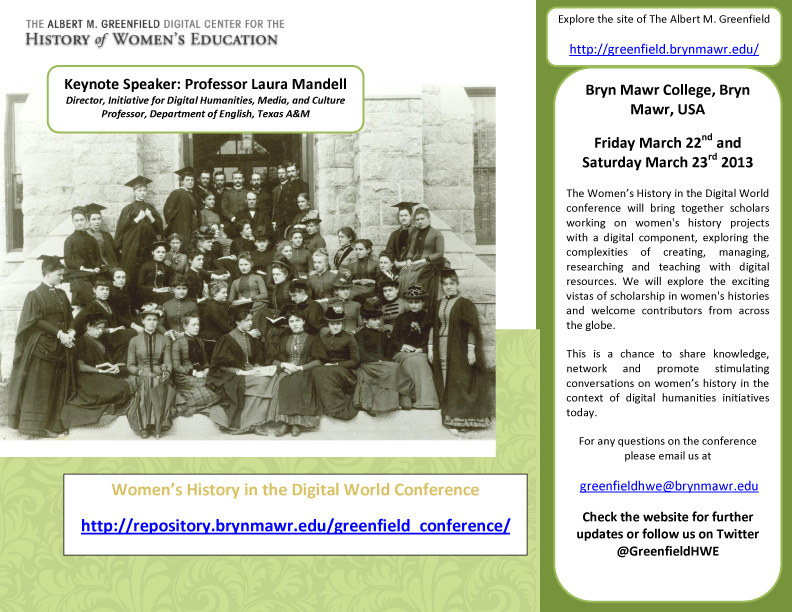 It’s almost time for the inaugural conference of The Albert M. Greenfield Digital Center for the History of Women’s Education!
It’s almost time for the inaugural conference of The Albert M. Greenfield Digital Center for the History of Women’s Education!
Women’s History in the Digital World offers a packed schedule of digital humanities projects that focus on women’s history. Participants are coming from across the US and the world to showcase their work, share information on tools, research, funding and practices, and most of all, meet each other in an environment wholly dedicated to women’s history issues in the digital era. Members of The Albert M. Greenfield Digital Center for the History of Women’s Education and its Advisory Board members will be in attendance to inform you about our work and our future plans.
Our keynote speaker, Laura Mandell is Director of the Initiative for Digital Humanities, Media, and Culture and Professor of English at Texas A&M University. She is the author of Misogynous Economies: The Business of Literature in Eighteenth-Century Britain (1999), a Longman Cultural Edition of The Castle of Otranto and Man of Feeling, and numerous articles primarily about eighteenth-century women writers, and Breaking the Book (forthcoming). She is Editor of the Poetess Archive, on online scholarly edition and database of women poets, 1750-1900, Director of 18thConnect, and Director of ARC, the Advanced Research Consortium overseeing NINES, 18thConnect, and MESA. Professor Mandell will speak on ‘Feminist Critique vs. Feminist Production in Digital Humanities’.
Registration is open and you must register online if you are planning to attend the conference by going to the registration page of the official conference website. It’s not too late to register! Registration fee is just $30 and this gives you access to the full conference, including the keynote and reception on Friday, all panels, coffee breaks and lunch on Saturday and a special closing reception at the gallery in Canaday Library to see Taking Her Place, 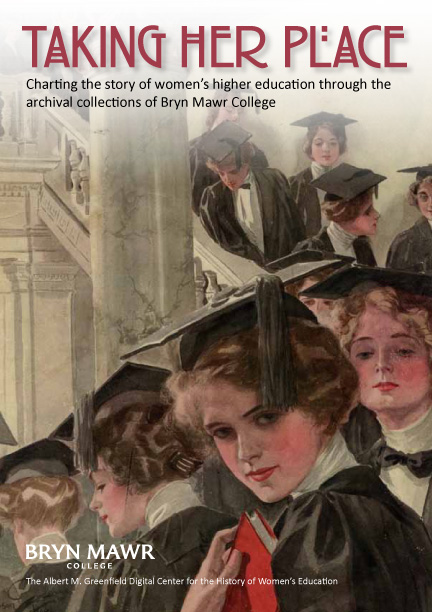 a show curated by The Albert M. Greenfield Digital Center for the History of Women’s Education. This will give conference attendees a final chance to engage with each other, view the collections of Bryn Mawr College, and wind down after a productive and fruitful gathering.
a show curated by The Albert M. Greenfield Digital Center for the History of Women’s Education. This will give conference attendees a final chance to engage with each other, view the collections of Bryn Mawr College, and wind down after a productive and fruitful gathering.
Don’t forget that, as advertised on the official conference website, we are also offering a free tour of campus at 3.30pm on Friday March 22nd before the conference begins. If you would like to attend the tour, please email greenfieldhwe@brynmwar.edu with ‘RSVP Tour’ in the subject line of the email.
Presenters at the conference are offered the ability to upload their presentations and related material to our institutional digital repository so they can be shared afterwards.
Our official conference hashtag is #WHDigWrld so if you’re coming to the conference don’t forget to promoted and follow the conversation using it, and as always, don’t forget to follow us on Twitter @GreenfieldHWE
For any queries about the conference, including registration, please email greenfieldhwe@brynmawr.edu. For specific queries about the work of the Center, please email the Director, Jennifer Redmond, at jredmond@brynmawr.edu
Come join us – we look forward to seeing you!
Registration Continues for the Women’s History in the Digital World Conference
 Registration continues for the Women’s History in the Digital World Conference, March 22nd -23rd 2013.
Registration continues for the Women’s History in the Digital World Conference, March 22nd -23rd 2013.
The conference brings together scholars, archivists, technologists, librarians, graduate students and those involved in the arts, heritage and cultural sectors to discuss their work on women’s history in the new realm of the digital world of research and teaching. Our keynote speaker on March 22rd, Professor Laura Mandell is Director of the Initiative for Digital Humanities, Media, and Culture and Professor of English at Texas A&M University. She will speak on ‘Feminist Critique vs. Feminist Production in Digital Humanities’ at 5.30pm in Wyndham and will be followed by a reception, also at Wyndham. Consecutive panels and a roundtable, featuring over 50 speakers, will happen on Saturday March 23rd.
We have developed a separate conference website where you can find directions to the campus, the registration form and the full conference schedule. This site also acts as a repository for conference related materials after the event, so if you can’t make it be sure to check back for copies of the presentations you missed. Registration is completed online, with the $30 registration fee to be forwarded separately via check.
For access to the official conference website go to http://repository.brynmawr.edu/greenfield_conference/
Please email greenfieldhwe@brynmawr.edu if you have any questions.
We look forward to seeing you!
‘Primary sources have the potential to help teachers in the classroom’: Temple student Adrian Wieszczyk on her experiences at Bryn Mawr
 This blog post has been written by Adrian Wieszczyk, a student at Temple University who is currently completing her training to become a high school teacher. Adrian is one of three students this year who used our collections as part of the National History Day Philly Cultural Collaboration Initiative. As with our other participants, we thank Adrian for her hard work and wish her all the best with completing her studies!
This blog post has been written by Adrian Wieszczyk, a student at Temple University who is currently completing her training to become a high school teacher. Adrian is one of three students this year who used our collections as part of the National History Day Philly Cultural Collaboration Initiative. As with our other participants, we thank Adrian for her hard work and wish her all the best with completing her studies!
My name is Adrian Wieszczyk and I am a student at Temple University. I have had the pleasure to work with Bryn Mawr College this semester through a field work internship. Through my experience I have felt very welcomed and aware of the resources and tools that Bryn Mawr provides, due to the helpful staff. As a result, I have discovered primary documents within the special collections that have potential to help teachers use primary documents within their classroom. The intended outcome of this internship through Temple was to introduce me to working with museums or archives as a future teacher and become more aware of resources provided. As for Bryn Mawr, my project was to create a lesson plan for their website using documents within their special collections. I believe that this project is very helpful for teachers, considering many teachers are unable to look through the rich resources and documents that institutions carry.
My particular focus was the female culture and role in the Prohibition era. I chose this topic because I found a few interesting documents that were published in Bryn Mawr’s Lantern of 1922-24 that discussed different perspectives and beliefs about the Prohibition. Unfortunately, I was unable to discover all of the documents and resources on the prohibition because of the time restraint but I was still able to take advantage of the documents I did find. My finalized project is a lesson plan called women in the prohibition. This lesson teaches the different organizations and cultures of females during the prohibition. For instance, the Women’s Christian Temperance Union, Women’s Organization for Prohibition Reform, and the cultural perspective of a “Flapper“. I really enjoyed researching these organizations as well as creating a lesson plan to further student’s knowledge of the female role in the prohibition.
Overall this experience has furthered my knowledge and skills as a student and as a future teacher. I have enjoyed developing relationships with the staff at Bryn Mawr as they have been extremely welcoming and helpful. I have learned a great deal about Bryn Mawr and other institutions in regards to getting involved as a future teacher. This knowledge will help me as I create lesson plans for my classroom and use the resources and primary documents that institutions, like Bryn Mawr College, carry and provide. I look forward to keeping in contact with Bryn Mawr College and using their digital archives to improve my upcoming lessons.
Call for papers: Women’s History in the Digital World, the first conference of The Albert M. Greenfield Digital Center for the History of Women’s Education
 Call for Papers: Women’s History in the Digital World
Call for Papers: Women’s History in the Digital World
Keynote Speaker: Professor Laura Mandell
Director, Initiative for Digital Humanities, Media, and Culture
Professor, Department of English, Texas A&M
Bryn Mawr College
March 22nd and March 23rd 2013
The first conference held by The Albert M. Greenfield Digital Center for the History of Women’s Education will be held on Bryn Mawr College campus and will bring together experts and novices to share insights, lessons, and information on the landscape of women’s history in the world of twenty-first century technology.
‘Women’s History in the Digital World’ will bring together scholars, archivists, digital humanists, students, and all those interested in the development of women’s history in the new era of digital humanities research. The conference will begin with a keynote address by renowned digital humanist, Professor Laura Mandell on Friday March 22nd, followed by a reception. Panels will be held all day on Saturday March 23rd.
The Center seeks scholars working on women’s history projects with a digital component, investigating the complexities of creating, managing, researching and teaching with digital resources. We will explore the exciting vistas of scholarship in women’s histories and welcome contributors from across the globe. Key issues, new projects, theoretical approaches and new challenges in the digital realm of historical and cultural research on women. All thematic areas and time periods are included: this is a chance to share knowledge, network and promote stimulating conversations in women’s history in the context of digital humanities initiatives today.
We invite individual papers or panels on new projects, theoretical approaches, teaching, research and new challenges in the digital realm of historical and cultural research on women.
Please email abstracts (200 words max) and a bio (100 words max) to greenfieldhwe@brynmawr.edu by December 14th 2012.
Check the website for further updates or follow us on Twitter @GreenfieldHWE
